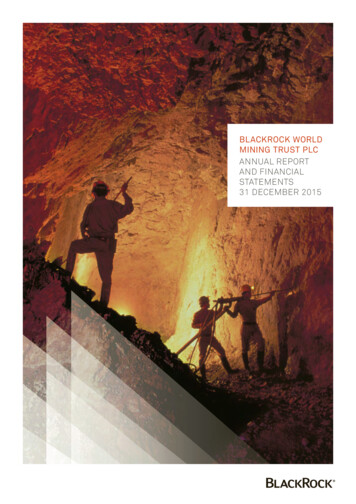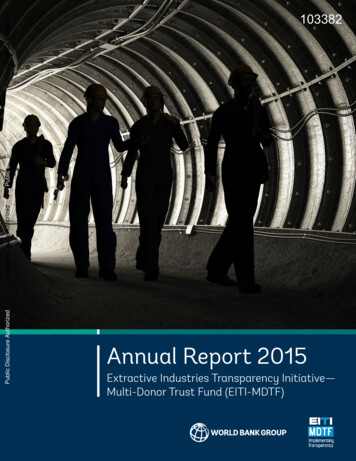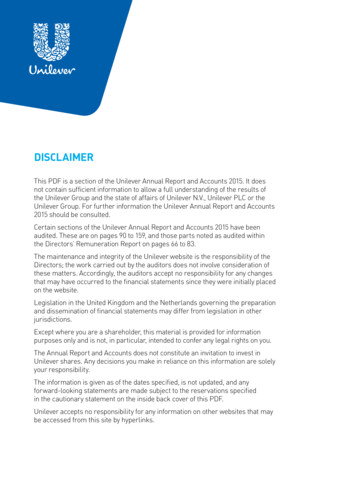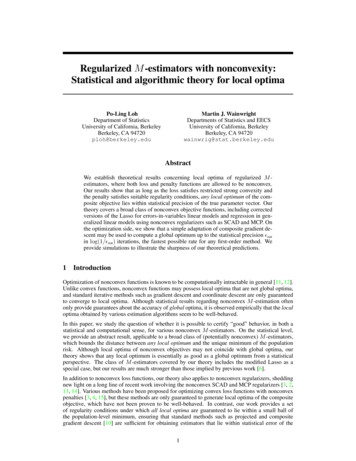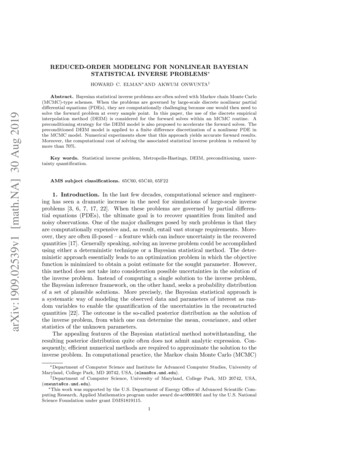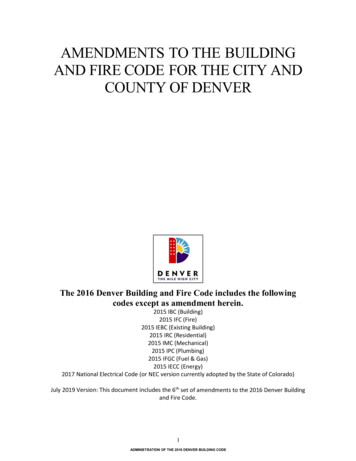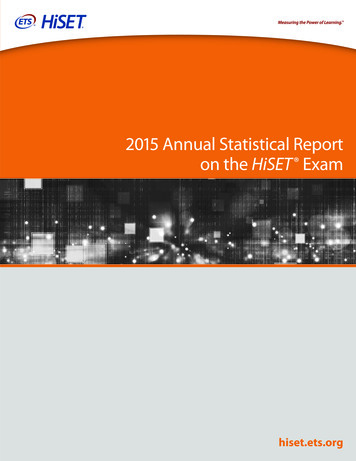
Transcription
2015 Annual Statistical Reporton the HiSET Examhiset.ets.org
Table of ContentsAbout HiSETAbout ETS.1About ITP.1Test Content.1OverviewThe HiSET Tests.2Table 1. Number of Test Items and Time Limits.2Scoring the HiSET Tests.2Explanation of the Scaled Scores.3Samples Reported.3State Policies.3HiSET Annual ReportThe Standard Setting.4Table 2a. Examinees Who Took and Passed Individual Tests.5Table 2b. Examinees Who Took and Passed Individual Tests in Spanish.6Table 3a. Number of Examinees Tested and Number of Batteries Completed in 2015.7 Table 3b. Number of Examinees Tested in Spanish and Number of Batteries Completedin Spanish in 2015.8Table 4a. Batteries Completed and Passed in 2015.9Table 4b. Batteries Completed in Spanish and Passed in Spanish in 2015. 10 Table 5. Means, Standard Deviations, and Percentage of Examinees by Age Group,by States and Total. 11Table 6. Percentage of Examinees by Gender, by States and Total. 12Table 7. Completers with Reported Hispanic Background. 13Table 8. Completers with Reported Race by States and Total. 14Table 9. Completers with Reported Education Level by States and Total. 15Table 10. Completers with Reported Mother’s Education Level by States and Total. 16Table 11. Completers with Reported Father’s Education Level by States and Total. 17Table 12. Completers with Reported Employment Status by States and Total. 18Table 13. Completers with Reported Reasons for Taking the Test by States and Total. 19Table 14. Completers with Reported Ways of Preparing for the Test by States and Total. 20Table 15a. Reading Formats Administered. 21
Table 15b. Writing Formats Administered. 22Table 15c. Math Formats Administered. 23Table 15d. Science Formats Administered. 24Table 15e. Social Studies Formats Administered. 25Table 16. Summary Statistics for Individual Tests. 26Table 17. Summary Statistics for Examinees Completing all Five Tests (The Full Battery). 27Table 18. Passers with Reported Reason for Testing. 28Table 19. Summary Statistics for Passers. 29Table 20. Passing Rates by Age. 30Table 21. Passing Rates by Gender. 31Table 22. Passing Rates by Reported Hispanic Background. 32Table 23. Passing Rates by Reported Race. 33Table 24. Year-to-Year Comparison of Examinees. 34Definitions of Key Terms. 352015 Annual Statistical Report on the HiSET Exam
IntroductionAbout HiSETEducational Testing Service (ETS ) and Iowa Testing Programs (ITP) co-developed the HiSET Program.The HiSET is an essential part of ETS’s mission to provide innovative and meaningful measurement solutionsthat improve teaching and learning, expand educational opportunities, and inform educational policy. Someindividuals who seek a high school credential may lack the opportunity to experience a traditionallystructured high school teaching and learning environment. The HiSET Program seeks to help theseindividuals identify, acquire, and demonstrate the knowledge and skills that they will need to succeed inpostsecondary education and in the workplace.About ETSFounded as a non-profit in 1947, ETS advances quality and equity in education for people worldwide bycreating assessments based on rigorous research. ETS serves individuals, educational institutions, andgovernment agencies by providing customized solutions for teacher certification; English language learning;and elementary, secondary, and postsecondary education — as well as by conducting education research,analysis, and policy studies. ETS develops, administers, and scores more than 50 million tests annually —including the College Board Advanced Placement Program (AP ) exams, the GRE General and SubjectTests, the National Assessment of Educational Progress (NAEP), and the TOEFL and TOEIC tests — in morethan 180 countries, at over 9,000 locations worldwide.About ITPITP is a non-profit research, development, and outreach unit in the College of Education at the University ofIowa. ITP’s mission is to pursue: research that improves the practice of educational measurement design and development of assessments for a variety of purposes and audiences includingeducators; federal, state, and local governments; and academic institutions outreach that delivers assessment results and supports the use of assessment information by local,state, national, and international audiencesTest ContentThe HiSET measures knowledge and skills in five subject areas: Language Arts — Reading, Language Arts —Writing, Mathematics, Science, and Social Studies.1
OverviewOverviewThe HiSET Program has been in operation since January 2014. This report provides volume and testperformance information for examinees who took the HiSET between January 1, 2015, and December 31,2015. The intent of this report is to help HiSET examinees, score users, and policy makers understand HiSETscores and to encourage appropriate score interpretation and use.The HiSET TestsHiSET examinees test in five content areas: Reading (Language Arts – Reading), Writing (Language Arts –Writing), Mathematics, Science, and Social Studies. The Test at a Glance documents — which are availablefor download on the HiSET Web site — provide descriptions of the specifications behind current HiSETforms. Each subject-area test produces a score on a 1–20 reporting scale. We used standard setting studies(Tannenbaum & Reese, 2014) to recommend the minimum test scores (i.e., cut scores) needed for examineesto be considered qualified enough to earn a high school equivalency certificate. The tests consist ofmultiple-choice items, except for a direct writing task associated with the Writing test. Table 1 displays thenumber of items and time limits associated with each test.Table 1. Number of Test Items and Time LimitsContent AreaNumber of ItemsNumber of MinutesLanguage Arts — Reading4065Language Arts — Writing50 essay120Mathematics5090Science5080Social Studies5070Scoring the HiSET TestsWith the exception of the Writing test, HiSET item responses receive a score of either correct or incorrect;and the sum of the correct responses becomes the raw score. There is no penalty for incorrectly guessing ananswer. Raw scores on the Mathematics, Reading, Science, and Social Studies tests are converted directly toscores on the 1–20 reporting scale. In Writing, the scaled score from the multiple-choice section is combinedwith the scaled score on the essay to produce the 1–20 reporting scale. We based the ratings of the essayscores in the Writing test on a 6-point rating scale that ranges from “little or no skill” to “proficient skill.”2015 Annual Statistical Report on the HiSET Exam2
OverviewExplanation of the Scaled ScoresEach of the five tests in the HiSET battery is scored on a scale of 1–20. In order to pass, an examinee must doall three of the following achieve a score of at least 8* on each of the five individual tests score at least 2 out of 6 on the essay portion of the Writing test have a total combined score on all five tests of at least 45* Minimum passing score is based on the HiSET “pass” cut score requirement. Credential issuing agenciesmay set their own minimum requirements. The pass rate data calculated in this report is based on the HiSET“pass” cut score requirement.Samples ReportedThe samples in this report sometimes refer to examinees who have taken individual tests; and sometimesthe samples refer to examinees who have taken the full battery of tests. All samples unless otherwise notedare composed of both English and Spanish examinees. For battery tables, examinees should have taken allfive tests in Spanish to be considered Spanish completers. Tables which include test-specific information arebased on the sample of examinees that have attempted the specific test. These tables are broken into twotypes of samples: 1) a sample of examinees which details their first attempt to pass a specific test, and 2) asample of examinees which encompasses all of their attempts to pass a specific test. The latter of the twoincludes multiple attempts by some examinees. Tables which include these samples are Tables 2, 3, 15, 16and 24.Tables which include information about the battery consist of only examinees that have completed all fiveindividual HiSET tests — however, completers have not necessarily passed the battery or any individualtest. Instead, a “completer” refers to an examinee that has completed the final test of their battery in 2015.This sample is broken into two subsamples for each individual test: 1) a subsample of first attempts, and 2)a subsample of best attempts (i.e., highest scores). Tables which include these samples are Tables 3, 4, 5, 6,7, 8, 9, 10, 11, 12, 13, 14, 17, 20, 21, 22, 23 and 24. In 2015, there were 47,775 completers. For the purposesof assigning examinees to a state, a completer is considered completed only in the state in which he or shemost recently tested. Tables based on “passers” include those completers who have passed the HiSET batteryon a first attempt. These samples occur in Tables 4, 18, 19, 20, 21, 22, 23 and 24.For certain identifying questions, examinees had the option to expressly indicate that they did not wish toprovide a response, or to simply refrain from responding at all. Response rates reported include those whoexpressly indicated that they did not wish to respond. The percentages for responses reported in the tables,including those who expressly chose not to respond, sum to 100 percent.In addition to the data reported for 2015, trend data comparing 2014 and 2015 are also included in thisreport and summarized in Table 24, which includes number tested, percent completed, and percent passingfor 2014 and 2015.State testing policies can be found at the following website:http://hiset.ets.org/requirements3
HiSET Annual ReportThe Standard SettingStandard-setting studies (Tannenbaum & Reese, 2014) were conducted in 2014 to recommend minimum test scores (cut scores)needed to be considered qualified-enough to earn a high school equivalency certificate. These recommendations were shared with theHiSET Governing Board along with other data to inform decisions about where to set the operational cut scores; these other sourcesof data included the correspondence between HiSET scores and scores on the GED and the ACT, and previous passing rates on theHiSET test. Based on a thoughtful and inclusive review and discussion, the recommended cut scores were lowered. Adjustments torecommended cut scores often occur to better align cut scores with their intended use (Geisinger & McCormick, 2010). This practice isconsistent with the understanding that the process of setting standards is similar to forming a policy, where the goal is to establish areasonable and appropriate decision-rule (Cizek & Bunch, 2007; Kane, 2001; Kane & Tannenbaum, 2013).Cizek, G. J., & Bunch, M.B. (2007). Standard setting: A guide to establishing and evaluating performance standards on tests. Thousand Oaks, CA: Sage.Geisinger, K. F., & McCormick, C.A. (2010). Adopting cut scores: Post-standard-setting panel considerations for decision makers. Educational Measurement: Issues and Practice, 29, 38–44.Kane, M. T. (2001). So much remains the same: Conception and status of validation in setting standards. In G. J. Cizek (Ed.), Setting performance standards: Concepts, methods, and perspectives (pp. 53–88). Mahwah, NJ: LawrenceErlbaum.Kane, M.T., & Tannenbaum, R.J. (2013). The role of construct maps in standard setting. Measurement: Interdisciplinary Research & Perspectives, 11, 177–180.Tannenbaum, R.J., & Reese, C.M. (2014). Recommending Passing Scores for the High School Equivalency Test (HiSET ) (RM 14–06). Princeton, NJ: Educational Testing Service.2015 Annual Statistical Report on the HiSET Exam4
HiSET Annual ReportTable 2a. Examinees Who Took and Passed Individual First Attempt9All Attempts13CAFirst Attempt10,378CAAll Attempts11,925GUFirst ingRate88.9980.01191.89,41890.912,4981283.3Social All Attempts1384.61283.31457.11283.31291.7HIFirst Attempt16884.517289.016963.917488.517577.1HIAll Attempts17584.017289.018761.017888.218674.7IAFirst .7IAAll 1.4LAFirst .6LAAll 4.4MAFirst .7MAAll 4.9MEFirst .1MEAll 5.9MOFirst .2MOAll 4985.4MPFirst Attempt3686.14693.53470.65096.04887.5MPAll Attempts3884.24793.63971.85196.15084.0MTFirst .2MTAll 5.5NCFirst Attempt66483.350791.747462.752185.856576.8NCAll Attempts73680.853591.458860.256084.366473.9NHFirst l 1.2NJFirst .8NJAll 5.4NMFirst Attempt1,04182.098286.296361.597489.199875.4NMAll 2.3NVFirst .4NVAll 8.6OKFirst Attempt22190.021989.519859.119687.820082.5OKAll Attempts22389.222489.721256.620287.620481.9PWFirst Attempt3452.94075.02437.54273.84839.6PWAll Attempts4348.84175.63839.54571.16040.0TNFirst .3TNAll 6.5WYFirst .5WYAll 6.9TotalFirst 51282.8TotalAll ,46778.85
HiSET Annual ReportTable 2b. Examinees Who Took and Passed Individual Tests in 36PassingRate55.4NumberTested1,877Social StudiesFirst AttemptCAAll 8.2IAFirst Attempt9889.810296.19968.78591.810483.7IAAll Attempts10987.210994.511764.19191.211383.2LAFirst Attempt8973.09078.98354.28875.08966.3LAAll Attempts10171.310178.211553.910575.211164.9MAFirst Attempt34751.931573.328131.330568.530154.5MAAll Attempts55445.737672.152131.941764.043651.6MEFirst Attempt785.7683.3––683.3––MEAll Attempts875.0771.4650.0785.7––MOFirst Attempt3881.63591.43735.13675.03675.0MOAll Attempts4875.04087.55933.94479.55064.0MTFirst Attempt––––––––––MTAll Attempts––––––––––NCFirst ate82.3NumberTested1,859PassingRate72.1NCAll Attempts17573.114593.818064.415983.018269.8NHFirst Attempt––––––––––NHAll Attempts––––666.7––––NJFirst Attempt21862.822571.121139.320567.321453.7NJAll Attempts28259.627069.631339.926166.329354.6NMFirst Attempt14077.913482.113054.612984.513174.8NMAll Attempts16273.515179.516857.114383.215373.2NVFirst Attempt12379.712482.312454.812283.612278.7NVAll Attempts16171.414979.920148.815077.315374.5TNFirst Attempt15872.815781.515352.315580.616067.5TNAll Attempts23265.119377.724347.720277.723364.4WYFirst Attempt2466.72564.02540.02680.82556.0WYAll Attempts3557.13066.73534.33083.33360.6TotalFirst .4TotalAll 6.0*Samples under 5 were not reported.**AS, GU, HI, MP, OK, and PW tested but did not have any tests administered in Spanish.2015 Annual Statistical Report on the HiSET Exam6ScienceNumberTested1,941
HiSET Annual ReportOut of the 61,600 examinees who tested, a total of 47,775 examinees had completed the full battery in 2015.The total completion rate was 77.6 percent.Table 3a. Number of Examinees Tested and Number of Batteries Completed in .61 Completers refer to as anyone who completed the battery in 2015, so if a person took 4 HiSET tests in 2014 and the last test in 2015, this person is considered a completer in 2015.7
HiSET Annual ReportTable 3b. Number of Examinees Tested in Spanish and Number of Batteries Completed inSpanish in 2071.4Total4,3892,75562.8*Examinees are only considered Spanish completers if all of the tests in their first battery were taken in Spanish.**Samples under 5 were not reported.***AS, GU, HI, MP, OK, and PW tested but did not have any tests administered in Spanish.2015 Annual Statistical Report on the HiSET Exam8
HiSET Annual ReportTable 4a. Batteries Completed and Passed in 2015StateSampleNumberCompletedNumber PassedPassing RateASFirst Attempt9555.6ASBest Attempt9666.7CAFirst Attempt8,9154,45950.0CABest Attempt8,9156,23970.0GUFirst Attempt11545.5GUBest Attempt11654.5HIFirst Attempt1628351.2HIBest Attempt1629357.4IAFirst Attempt1,8901,53781.3IABest Attempt1,8901,80895.7LAFirst Attempt6,6033,62154.8LABest Attempt6,6034,69971.2MAFirst Attempt5,0582,71953.8MABest Attempt5,0583,58070.8MEFirst Attempt1,11977068.8MEBest Attempt1,11995685.4MOFirst Attempt9,0955,77963.5MOBest Attempt9,0957,35980.9MPFirst Attempt261661.5MPBest Attempt262284.6MTFirst Attempt1,5801,06867.6MTBest Attempt1,5801,31883.4NCFirst Attempt40320651.1NCBest Attempt40329773.7NHFirst Attempt97173775.9NHBest Attempt97185087.5NJFirst Attempt1,08747543.7NJBest Attempt1,08765460.2NMFirst Attempt87439845.5NMBest Attempt87462871.9NVFirst Attempt2,5941,42054.7NVBest Attempt2,5941,83770.8OKFirst Attempt1748347.7OKBest Attempt1749152.3PWFirst Attempt16531.3PWBest Attempt161062.5TNFirst Attempt6,0013,16552.7TNBest Attempt6,0014,21270.2WYFirst Attempt1,18780868.1WYBest Attempt1,1871,01985.8TotalFirst Attempt47,77527,35957.3TotalBest Attempt47,77535,68474.79
HiSET Annual ReportTable 4b. Batteries Completed in Spanish and Passed in Spanish in 2015StateSampleNumberCompletedNumber PassedPassing RateCAFirst Attempt1,61264940.3CABest Attempt1,6181,08967.3IAFirst Attempt674770.1IABest Attempt696289.9LAFirst Attempt823542.7LABest Attempt834959.0MAFirst Attempt2394820.1MABest Attempt23710443.9MEFirst Attempt–––MEBest Attempt–––MOFirst Attempt33824.2MOBest Attempt321753.1NCFirst Attempt1295945.7NCBest Attempt12910581.4NHFirst Attempt–––NHBest Attempt–––NJFirst Attempt1914423.0NJBest Attempt1897841.3NMFirst Attempt1165144.0NMBest Attempt1168169.8NVFirst Attempt1215343.8NVBest Attempt1247963.7TNFirst Attempt1404532.1TNBest Attempt1387755.8WYFirst Attempt20315.0WYBest Attempt20840.0TotalFirst Attempt2,7551,04237.8TotalBest Attempt2,7591,75063.4* Examinees are only considered Spanish completers if all of the tests in their first or best battery were takenin Spanish.**Samples under 5 were not reported.***AS, GU, HI, MP, MT, OK, and PW tested but did not have any complete batteries administered in Spanish.2015 Annual Statistical Report on the HiSET Exam10
HiSET Annual ReportExaminees who reported being under age 16 were removed from the sample. The average age of the total group was 26 years.Examinees who were 16 to 18 years old accounted for 22.5 percent of all examinees; examinees who were 19 to 24 yearsold accounted for 35.2 percent of all examinees; examinees who were 25 to 34 years old accounted for 25.2 percent of allexaminees; and examinees who were 35 years old or older accounted for 17.1 percent of the total group. For this table, actualages are always rounded down to the nearest whole year (e.g., 24 years and 8 months is rounded down to 24 years).Table 5. Means, Standard Deviations, and Percentage of Examinees by Age Group, by States, and TotalStateNumberAgeMeanAgeSD16 to 18(%)19 to 24(%)25 to 29(%)30 to 34(%)35 to 39(%)40 to 49(%)50 to 59(%)60 .87.02.80.5* Samples under 10 were not reported.11
HiSET Annual ReportOf the 47,775 examinees who reported gender (i.e., female or male), 55.7 percent reported as male, and44.3 percent reported as female.Table 6. Percentage of Examinees by Gender, by States, and TotalStateNumberMale (%)Female TN6,00156.443.6WY1,18763.736.3Total47,77555.744.3* Samples under 10 were not reported.2015 Annual Statistical Report on the HiSET Exam12
HiSET Annual ReportOf the 47,270 examinees who self-reported background, 63.1 percent self-reported as non-Hispanic,22.5 percent reported as Hispanic, and 14.4 percent indicated that they did not wish to report whether ornot they were Hispanic.Table 7. Completers with Reported Hispanic BackgroundNon-Hispanic(%)Hispanic(%)ChoseNot toRespond(%)State 47,27098.963.122.514.4* Samples under 10 were not reported.13
HiSET Annual ReportOf the 47,248 examinees who self-reported race, 53.4 percent reported as White, 16.3 percent reported as AfricanAmerican, and 14.9 percent expressly indicated that they did not wish to provide any racial classification. Examineeswho indicated being Hispanic had the option of separately reporting a racial identification indicated in this table. Theunderlying survey question on which this table is based did not include a Hispanic category, which may have led Hispanicexaminees to choose “Other” or to not respond — either by expressly indicating a desire not to choose a category or bynot choosing any option whatsoever.Table 8. Completers with Reported Race by States and hite(%)Other(%)ChoseNot 4898.93.82.016.30.953.413.814.9* Samples under 10 were not reported.2015 Annual Statistical Report on the HiSET Exam14AmericanIndian(%)ResponseRate(%)
HiSET Annual ReportOnly 66.3 percent (31,672) of all examinees reported their education level. Of the examinees reporting, themajority (91.6 percent) had some high school — that is, 9th through 12th grade — education.Table 9. Completers with Reported Education Level by States and TotalStateCountRe
five tests in Spanish to be considered Spanish completers. Tables which include test-specific information are based on the sample of examinees that have attempted the specific test. These tables are broken into two types of samples: 1) a sample of examinees which details their first attempt to pass a specific test, and 2) a

